
Issue #: 143
Published: September / October 2015
- Price per issue - digital : 5.40€Digital magazine
- Access to Multihulls World digital archives Digital archives
We find ‘Jangada’, the catamaran belonging to Olivier and his family, on the way to the forbidden atoll of Rose Island, a Samoan dependency…
Rose Island, the forbidden atoll... I could start like this: “Allow me to announce to you that the corvette ‘l’Uranie’ has discovered, to the east of the Navigator’s archipelago, a small island which is to be found on none of the most recent charts of these seas, and that the Captain of the aforementioned corvette has named this island Rose. It has therefore been done, my name is now attached to a small point on the globe (a very small one, in fact, because envious people would perhaps only call it an islet, which it is); encountered at night, it could have been fatal for us, in the place where, as it is marked on the expedition charts, we will from now on beware, and no one, I hope, will perish on the dangers which surround Rose Island.” Journal du voyage autour du monde à bord de l’Uranie 1817 – 1820. Thus wrote Rose de Saulces de Freycinet, in her log book on 21st October 1819, after the discovery of the little atoll (which bears her name) by the French vessel captained by her husband, the geographer and explorer Louis de Saulces de Freycinet. She had the nerve to follow him aboard at the age of 23, against all the accepted behavior at the time. Rose was thus the second French woman to sail round the world... Situated in the South Pacific, around 150 miles south-east of Pago Pago, look for Rose somewhere between the Cook, Samoa and Tonga Islands. The little atoll is American, and is part of the US territory of Samoa. Rose is an uninhabited atoll, which has recently become a National Wildlife Refuge, managed by the US Fish & Wildlife Service. Practically square, the atoll measures hardly more than 2km per side. It contains just two small islands - Sand Island in the north, a little tongue of sand bereft of all vegetation, and Rose Island to the east, just 3.5 metres high. A perfect little island...but closed to the public, with access now reserved for authorized scientists. But as I am above all a citizen of Planet Earth, I didn’t like this notion very much. Thanks to the watchkeepers’ eyes aboard the Uranie, I considered Rose to be a little bit French!
..but the island is forbidden, and the US navy was present in front of our anchorage. Here is the only view we had of Rose.
It was enough for me to think that we, the French crew aboard Jangada, had naturally inherited from this illustrious compatriot the right to a visit (naturally highly ecological) to Rose’s atoll... A discrete stopover there, perfectly respectful of the laws of nature, strongly tempted me. On Suvarov, I learnt confidentially of a little message sent about ten days earlier by a sailing boat which had stopped there for a few days, alone and without mishap. Encouraging. Rose atoll belongs above all to the turtles, to thousands of seabirds, and a multitude of reef fish. A pass of around forty meters, which must be located carefully before entering, links Rose’s lagoon to the ocean, in the north. I had a chart which was sketchy, but enough to enter the lagoon. The Americans at the US Fish and Wildlife Service, the same ones who are in charge of the protection of Rose atoll, must regret having given (for several thousand dollars) a fishing license to a Taiwanese long-liner which in October 1993 was shipwrecked on Rose's reef, spilling some 400 tonnes of hydrocarbons on this little jewel of the Pacific...not to mention a heap of scrap metal. A nice but very official little mess... Which goes to show that, on the contrary to what one could believe, state management of an exceptional natural site doesn’t necessarily provide the solid guarantees in terms of protection of the environment that we have the right to expect from such a status. I was certain that our visit to the anchorage in the Rose Island lagoon would have an infinitely lower impact (or even none at all) on the atoll than any scientific expedition setting up ashore in a non-independent way, with tents, Coca Cola, generators and night time lighting, and even less so than that of the Taiwanese fishermen disembarking on the coral reef, with just a few tonnes of fuel each as luggage! A sailing boat has an extremely discreet ecological footprint, if its crew takes the trouble to observe a few simple rules. Let’s go!
However it seemed nice. We’ll have to return…
We left Suvarov atoll with a strong easterly wind. The pass was a bit rough. On Suvarov, we said we were heading for Niue Island, which wasn’t false... But we didn’t say anything about our detour via Rose atoll. The following night, a large area of squalls hit us. The wind roared at 40 knots and the sea got rougher; we furled the mainsail and continued under jib alone, slowly, to wait for daylight. A pale glow was a substitute for it, and around 300 miles after our departure from Suvarov, I glimpsed to starboard the short dark line formed by the tops of the coconut trees on an island placed on the ocean. Rose atoll. We couldn’t yet make out the reef, on which the rough seas must have been breaking violently. I corrected our route slightly, to sail close to the north of the atoll, on the pass side. Marin and Adélie appeared in the cockpit. I showed them Rose Island, which was getting bigger by the minute. Adélie, true to form, asked me:
- Daddy, how long are we going to stay on Rose?
Cautiously, I merely replied that we weren’t yet there. One detail was worrying me. Straight ahead, about 4 – 5 miles away, I had just glimpsed through my binoculars the silhouette of what I at first took to be a fishing boat. I would have preferred him to go and exercise his activity elsewhere; I said to myself that if he saw us entering Rose lagoon, he could easily warn the American Samoas by radio of the presence of a sailing boat in the area... As the minutes passed, I became more and more worried. At 2 miles, I saw that this vessel, which was around 80 meters long, didn’t have the profile of a long-liner fishing for tuna, but that of a supply ship! I even caught a glimpse of some containers on the aft deck, and a whole pile of technical equipment. Even more alarming – it was circling just in front of the pass. Damn! Our discreet stopover at Rose Island was in a bad way! With my eyes riveted to the binoculars, I could now see a decked launch leaving the ship and heading towards the pass. The first trip of the day! We were only half a mile away, and I noted that Rose’s leeward beach, over in the lagoon, was strewn with a multitude of tents and crates of equipment. Numerous brightly-colored silhouettes were moving around on the beach of my perfect island. Each more scientific than the other. Hard luck for us humble discreet sailors: the idea of spending a few serene, idyllic days in Rose Island’s lagoon, incognito, suddenly vanished... The reality hit us hard: a real invasion had taken place on Rose Island!
At Niue, the Pacific swell obliges sailors to take their dinghy out of the water to disembark! Marin loved this.
At the same time as I was announcing to my family that we would have to forget the prospect of spending a few days peacefully in Rose’s little lagoon, which was passing 200 meters to port, I was wondering what story I was going to tell this ship, the Motor Vessel Sili, which was now heading towards us, without a doubt to enquire what we were doing there... The VHF crackled just as we crossed the axis of the pass, heading west still under jib alone, which was pulling us along at 6 knots.
- French sailing boat approaching Rose Atoll, from US Government supply ship Sili, what are your intentions please?
- Yes, Sili, good morning Sir! This is French sailing catamaran Jangada, up one!
- OK, going up!
Then, on channel 17:
- Jangada, good morning, what are you doing here?
- Oh nothing special, Sir, we are just coming from Suvarov, going to Tonga, and passing close to Rose Atoll! Rose is a natural reserve from American Samoas, right?
- Yes, that’s right. Access to Rose is forbidden, only authorized for scientific research!
- Yes, I know, I know!
A moment’s silence followed, probably the time he took to ask himself if I was seriously trying to pull a fast one. But we had by now passed the access to the atoll, the pass was behind us and I hadn’t maneuvered, leaving our boat to continue its temporary route west. The US captain couldn’t accuse us of anything. He then enquired about the weather we had had the previous night; he too had been thrown around a bit.
I continued, perhaps teasing him a little:
- And I can see you are supporting a big scientific expedition?
- Oh yes, we have been here for a week, with many people and a lot of equipment to land! And the weather is bad!
I sympathized. The captain confirmed that he had too great a draft to enter the lagoon with his supply ship; he was condemned to remain at sea, close to the pass, burning fuel... Anchoring is impossible outside the lagoon, the seabed drops away steeply. The launch provided a shuttle service between the boat and the shore. From time to time, ecology and scientific research take turnings which sometimes make me smile.
So, no, at the moment when Rose’s atoll was already starting to recede in our wake, and with it the silhouette of the M/V Sili, I didn't regret having tried to gain access to it for a few days stolen from the American administration, a few days we would have spent discreetly in keeping with the natural environment, with no other ecological trace than that of our boat’s anchor, a short-lived ‘footprint’ left for a few hours in the sand in front of the beach, quickly removed by the sea’s currents. But for the moment, we had to face up to the disappointment – mine, but perhaps even more so that of my little crew, who thought they were at the end of the passage... I carried on west for a few miles in the direction of the Tonga Islands, then all that remained was to sail close-hauled towards Niue Island, which was now our destination. The wind remained strong in the area. What’s more, multihulls, taking into account their speed over the water, have a proven ability to create apparent wind, and bring it a bit further forward, it’s well-known. So we re-hoisted the mainsail, but this time with three reefs, and rolled up a bit more jib. Time to sail close to the wind and the seas! Heading for Niue, 290 miles away on a close reach... Tough for the crew’s morale. But we had no choice.
Marin improves his hunting technique in the Pacific…
My ruse had been blown apart. All we could do was thrash to windward without complaining. Rose was disappearing on the horizon. The wind was blowing from the south-east alas, at a steady 25 knots, with gusts of 30, sometimes 35. Jangada was sailing at 8 knots, climbing the waves, following a direct route, cutting powerfully through the sea. But it was uncomfortable. The deck became wet, the portholes were closed to the last notch; the following 48 hours weren’t going to be much fun... Those two days will remain in my memory as ‘the punishment for Rose’. The wind didn’t die down, and the weather map I got from Saildocs didn’t predict any rotation to the east for the trade winds. I trimmed the boat carefully, making sure that not too much strain was put on the structure. Our catamaran is beamy, therefore powerful, and the forces can increase rapidly. But with reduced sail I didn’t feel that it was being strained, and it covered its eight miles every hour with no apparent effort, while sailing through a minefield. I took in the slack in the leeward shrouds with a line, reinforced the lashings of the dinghy on its davits, perfected the stowage on deck. I optimized the shape of the mainsail, took in the leech line, checked there was no chafe on the 3rd reef pendant, which was under strong tension. I sprayed some WD40 on its sheave, which tended to squeak under the force. It was finally silenced. I checked the route followed over the ground on the GPS, corrected the course displayed on the autopilot by one or two degrees, to compensate for a bit of leeway. All that remained was to eat up the miles whilst conserving our strength and if possible, at least to all appearances, displaying unfailing good humor...
But my little crew’s faces were uncommunicative, more worried than usual. Barbara doesn’t like this point of sailing, where a catamaran’s movements are brutal, often diagonal. As the hours passed, I saw her morale crumble, she grinned and beared it, but internalized her anxiety, which is not a very good solution. However it’s hard to do otherwise, when apprehension and discomfort overcome you. The children, who knew that it would take us 48 hours at this speed, settled down to it more easily. Electronic games, alternating with a bit of reading, all coupled to the absence of school, helped them a lot. During this passage, the waves sometimes reached 5 meters, and the wind force 7 with gusts of 8. The sky was overcast and gray, and heavy low clouds were speeding rapidly westward.
I settled down in the salon for a ‘landfall’ night, having preferred to send Barbara to her bunk down below, in the warmth and darkness of the port hull, in safety. It was easier for me. As usual when at sea, Adélie took over the port settee in the salon. I could hear her steady breathing, which told me she was sleeping peacefully. She calls this ‘keeping watch with Daddy’. I smiled with pleasure. I like her presence; it helps me get through the night. As the hours passed, I corrected the route to our landfall, and towards midnight, I caught a glimpse of a vague glow on the horizon: Niue Island was approaching. We gradually reached the shelter of the island. I woke Marin, who helped me furl the mainsail, and we headed towards the Alofi anchorage area, where I knew we would be able to find some mooring buoys installed by the Yacht Club. The seabed drops away very quickly close to the coast, and this anchorage is not particularly well protected. We finally found a buoy with the help of our hand-held spotlight, and once tied up to its solid ring, Jangada could take a breather after all the effort. The echo sounder showed 40 meters. The stampede over the waves had ended. I fell asleep quickly.
Barbara’s opinion on the importance of a stopover at Niue was cutting. The pretty lieutenant hadn’t enjoyed our last two days. And Niue got it in the neck. The island is made up of a coral plateau, with no particular charm, which stands on the remains of an underwater volcano. There is no lagoon; the island is encircled by 25-metre high cliffs, fringed by a narrow coral reef. Access is not easy. The ground is quite poor and tortured; there is dead coral everywhere. Dense vegetation made up of wizened bushes covers it completely, only rarely giving way to a few trees, concentrated in Huvalu forest, in the south-west of the island.
We quickly discovered two of Niue’s distinctive features.
The first was that because of the backwash which is rife in Alofi bay, each time we went ashore, we had to crane the dinghy out of the water onto the harbor’s little jetty, to avoid damage. The children loved carrying out this maneuver; the crane was free for anyone to use, and there was no shortage of manpower. We took advantage of this opportunity to scrub it off easily. The second, less pleasant, was that we quickly noticed that the water in Alofi bay was inhabited by...sea snakes! Little venomous snakes, Laticaudaschystorhyncha, which we were told couldn't bite us, a small consolation. It’s not that they don’t want to, but their mouths are too small. This assertion didn’t convince Barbara sufficiently, and at Niue, she didn’t go swimming as she had done at Suvarov, escorted by sharks...
There is no coral reef at Niue, just coral cliffs…
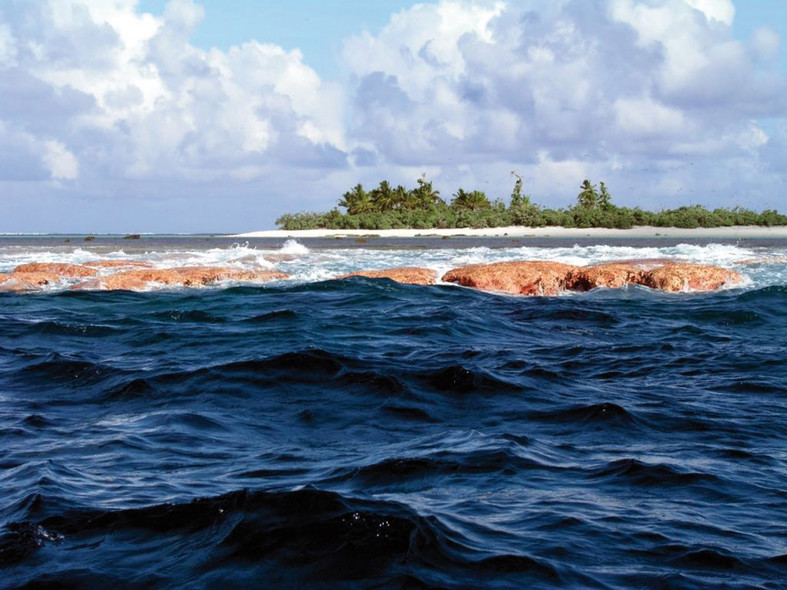
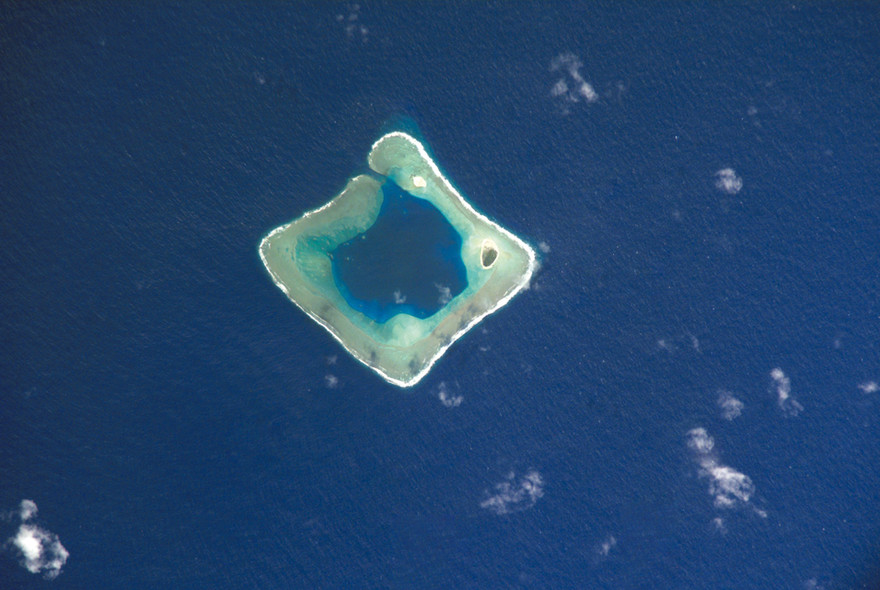
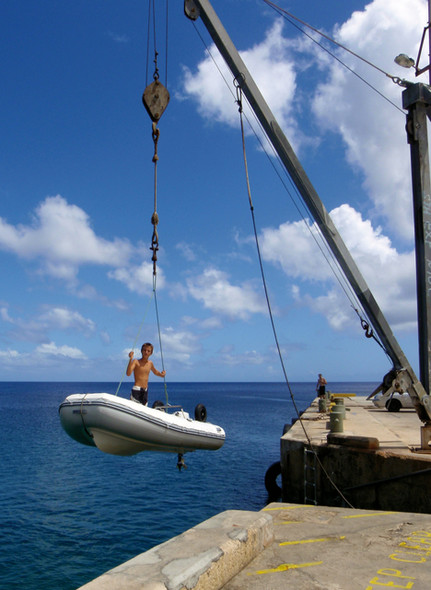
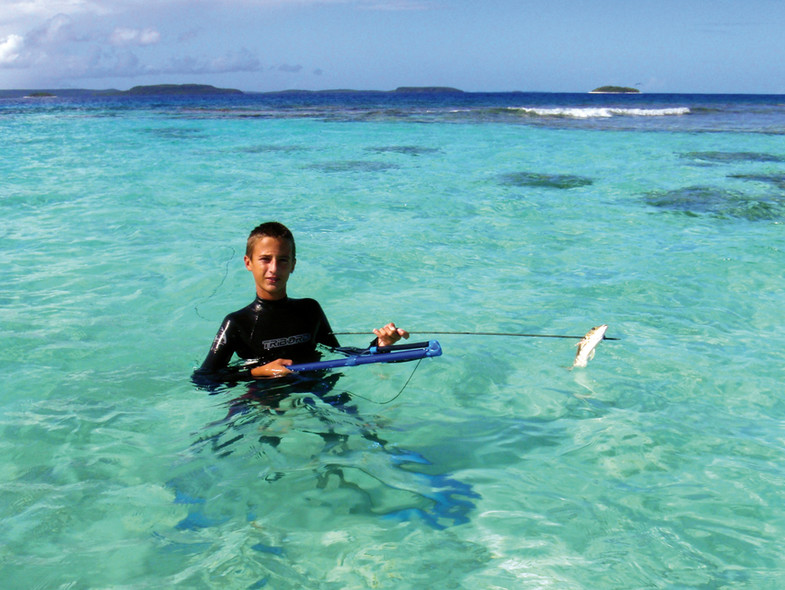
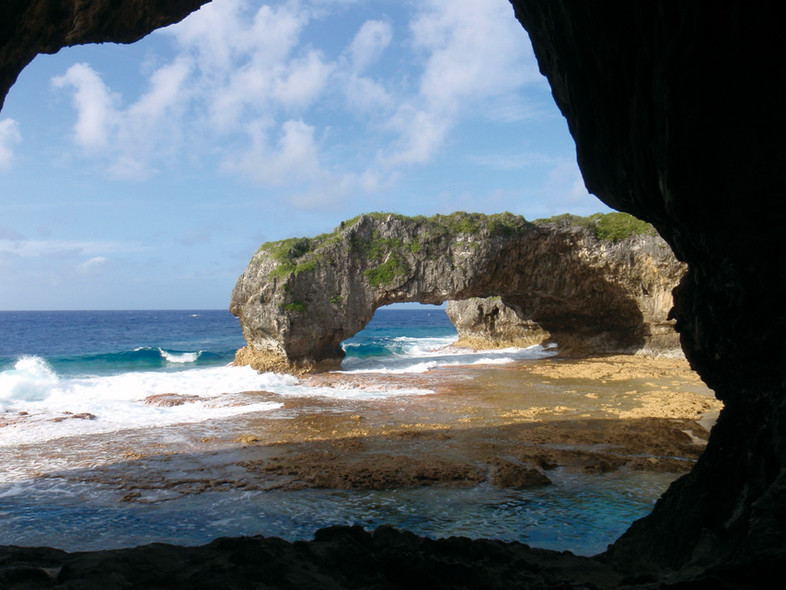
What readers think
Post a comment
No comments to show.